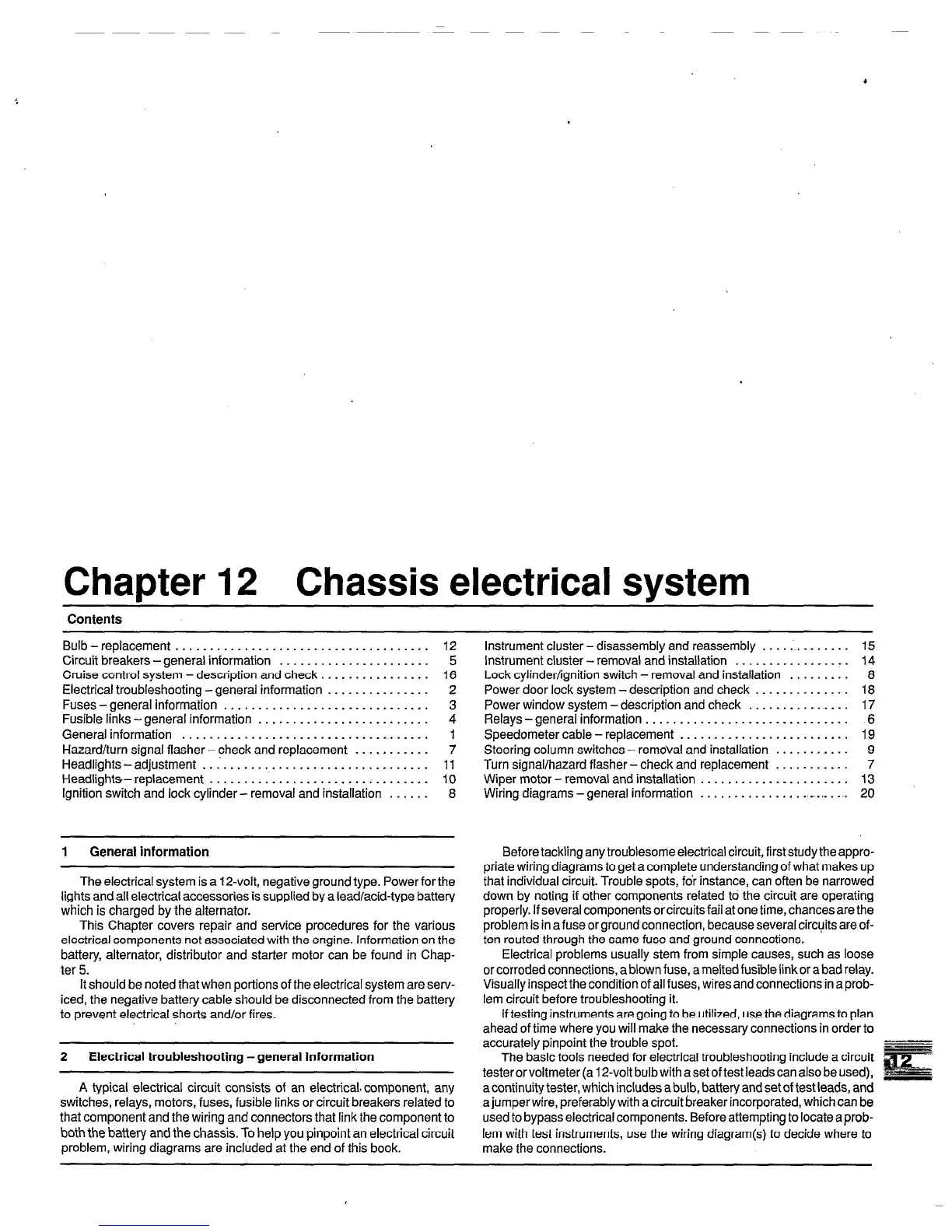,
Chapter 12
Chassis electrical system
Contents
Bulb -replacement ..................................... 12
Circuit breakers -general information ...................... 5
Cruise control system - description and check ................ 16
Electrical troubleshooting -general information ............... 2
Fuses -general information .............................. 3
Fusible links-general information ......................... 4
General information .................................... 1
Hazard/turn signal flasher-check and replacement ........... 7
Headlights -adjustment ................................. 11
Headlights- replacement ................................ 10
Ignition switch and lock cylinder - removal and installation ...... 8
Instrument cluster-disassembly and reassembly . . .
Instrument cluster - removal and installation . . . . . . _
Lock cylinder/ignition switch - removal and installation
Power door lock system - description and check . _ . .
Power window system -description and check . . . . _
Relays -general information . . . . . . . . . . . . . . . . . _ . .
Speedometer cable - replacement . . . . . . . . . . . . . . .
Steering column switches - removal and installation
Turn signal/hazard flasher-check and replacement .
Wiper motor -removal and installation . . .,........
Wiring diagrams -general information . . . _ . . . . _ _ . .
.~. _- . .
. . .._.
. . . . . .
. . . . . .
-..-..
. . . . . .
. . . . . .
. . ..__
. ..I._
. . . . . .
. . ..I._
. .
15
-_ 14
. . 8
. . 18
. . 17
. .
6
. . 19
. . 9
. . 7
. . 13
. . 20
1 General information
The electrical system is a 12-volt, negative ground type. Power for the
lights and all electrical accessories is supplied by a lead/acid-type battery
which is charged by the alternator.
This Chapter covers repair and service procedures for the various
electrical components not associated with the engine. Information on the
battery, alternator, distributor and starter motor can be found in Chap-
ter 5.
It should be noted that when portions of the electrical system are serv-
iced, the negative battery cable should be disconnected from the battery
to prevent electrical shorts and/or fires.
2 Electrical troubleshooting -general Information
A typical electrical circuit consists of an electrical! component, any
switches, relays, motors, fuses, fusible links or circuit breakers related to
that component and the wiring and connectors that link the component to
both the battery and the chassis. To help you pinpoint an electrical circuit
problem, wiring diagrams are included at the end of this book.
Before tackling any troublesome electrical circuit, first study the appro-
priate wiring diagrams to get a complete understanding of what makes up
that individual circuit. Trouble spots, for instance, can often be narrowed
down by noting if other components related to the circuit are operating
properly. If several components or circuits fail at one time, chances are the
problem is in a fuse or ground connection, because several circuits are of-
ten routed through the same fuse and ground connections.
Electrical problems usually stem from simple causes, such as loose
or corroded connections, a blown fuse, a melted fusible link or a bad relay.
Visually inspect the condition of all fuses, wires and connections in a prob-
lem circuit before troubleshooting it.
If testing instruments are going to be utilized, use the diagrams to plan
ahead of time where you will make the necessary connections in order to
accurately pinpoint the trouble spot. --
The basic tools needed for electrical troubleshooting include a circuit
testerorvoltmeter (a 12-volt bulb with a set of test leads can also be used),
- acontinuity tester, which includes a bulb, battery and set of test leads, and
a jumper wire, preferably with a circuit breaker incorporated, which can be
used to bypass electrical components. Before attempting to locate aprob-
lem with test instruments, use the wiring diagram(s) to decide where to
make
the
connections.

